#branch-networking
Explore tagged Tumblr posts
Text

#us politics#western politics#political memes#fafo#fox news#donald trump#fuck maga#maga 2024#maga cult#tarrifs#president trump#trump administration#fuck trump#united states#i live in the us#politics#political#political quotes#political commentary#united states of america#make america great again#make america smart again#make america healthy again#donald j#donald j trump#fox network#civil rights#executive branch#impending doom#too late
50 notes
·
View notes
Text
some of you people cannot engage with black musicians unless they got a white feature in it, and it really shows sometimes
#network malfunction#or just non east asian musicians if i wanna be more broad in terms of poc#“What if I don't like the rest of their work :(” I'd rather see some form of meaningful engagement and realizing you dont vibe with em Then#Than pure stagnancy to branch out at all#goes doubly for queer black musicians#anyways go listen to BACKxWASH new album or I Will Kill You
20 notes
·
View notes
Note
Do psychotropic drugs and/or ritual play a role in any of the blightseed cultures? A pretty broad question, lol
Yeah that’s a very broad question, the answer is about as much as it tends to play roles in real history. Alcohol is pretty ubiquitous (outside of cultures that abstain from intoxicants) and used for a variety of purposes, opioids are commonly used in some parts for pain relief or recreational purposes, stimulants (usually in mild, natural forms) are used to provide extra energy, and hallucinogens are most commonly used as part of a larger religious framework (rather than for recreational purposes). Any more elaborate answer kinda has to be case by case in a certain culture or part of the setting.
I'll just take this as an opportunity to talk about the one established sect that pretty much REVOLVES around psychoactive use. This is the Scholarly Order of the Root, which is a sort of mystery religion + elite community of scholars who currently occupy the Ur-Tree and its forest in the far southern Lowlands (southeast of Imperial Wardin, on the same land mass).
The Ur-Tree is the obligatory Huge Fucking Fantasy Tree (and its surrounding forest). It’s a mass of vegetation about a mile tall and almost as old as Plant Life Itself, its upper branches are primeval plants, which become more modern the nearer they get to the ground (and each 'level' holds tiny ecosystems, some containing descendants of LONG-extinct arthropods/other small animals). Its lowest branches and the surrounding forest are contemporary plant life, and all is connected and protected by an incomparably MASSIVE fungal mycelium network (which is itself a living god).
A lot of the Scholars' more secretive practices revolve around experimentation with substance use with the goal of expanding the Mind and transcending the body to fully connect to the Dreamlands, and they have a supply chain of traders and mercenaries called Rootrunners who traffic substances into the Lowlands. Most of their psychoactive use is in a very intentional capacity and not just like, for fun, but a LOT of them are just straight up addicted to cocaine (in the form of alchemically refined bruljenum, which is used for practical purposes of its stimulant effect during long hours of work).
All known psychoactives are desirable for experimentation (particularly hallucinogens), with each having properties that either allow expansion of the Mind, transcendence of the body, or outright divine communion. Their effects are logged in great detail and interpreted to form the basis of the Scholars' understanding of the natural world and reality itself.
The most important substance is Ur-Root, which is root matter from subterranean levels of the Ur-Tree that have both their own intrinsic psychoactive substances and a very, very high concentration of living god mycelium. The tree root contains DMT and the mycelium has its own wholly unique effects (being an actual living god). They alchemically refine it into a purer, more potent form, and use it to expand beyond the body and directly commune with the Giants, a group of entities they have identified as the only true gods.
An Ur-Root trip starts off with minor visual distortion, which turns into shifting fractals that slowly obscure the vision. Eventually the senses are entirely taken over by a 'tunnel' of rapidly shifting fractals and geometries. In a complete trip, the experiencer gets a sense that they have been pushed through a membrane and entered another realm, finding themselves in a distinct experiential Space.
At this point they may encounter entities which communicate to them in a language impossible to describe but wholly understood. These beings are understood to be the Giants, or at least aspects of the Giants that mortals are capable of comprehending (they often take familiar tutelary forms of the Mantis or the Snake, or appear resembling the same type of sophont that the experiencer is, all composed of ever-shifting geometries). The experiencer often feels a sense of unconditional and endless love from these beings, though the Giants may be more hostile and may appear in the form of the Trickster (usually a cultural figure regarded as malicious, be it an animal or otherwise) in a bad trip.
(^Up until this point, this has mostly just been a DMT 'breakthrough' experience ft. 'machine elves' and the like).
They are then removed from this space and returned to something that feels like the real world, but is nearly unrecognizable. They have a sense of rapidly moving through time, and will usually see 'the spires' towards the beginning, which just so happen to look like this:

(source + some context via Implication- the spires are exactly what this art is depicting)
The experiencer continues to move across an unfathomable amount of time, occasionally 'seeing' other such flashes of unfamiliar landscapes and creatures, and yet also being devoid of all their senses, the 'seeing' is pure, unfiltered experience. There is a sense of interconnectedness with all life, and that one has become the forest (or even Life) itself. The sense of time is wildly distorted, the trip lasts only about 5 minutes but feels like an eternity and is understood as literal hundreds of millions of years.
The experiencer has usually lost any remaining sense of Self and individual consciousness during this phase (in which case this time distortion is usually a neutral or even peaceful experience), but some retain a fraction of their identity, and find themselves trapped and conscious while experiencing what feels like eternity (which can be LIFE-CHANGINGLY distressing, even after the fact).
(^This latter part of the trip is the effects of the Ur-Tree fungus).
The trip ends with a sense of rushing through the ground and back up into one's body, at which point they will abruptly return to their senses and consciousness. The details are then immediately retrieved via interview and recorded in immense detail. The whole experience is understood as having been full comprehension of the Dreamlands, communion with the Giants, and then a tour through the act of creation.
This is done as part of the initiatory practice into the inner mystery-religion of the scholars, and as needed for study by high scholar-priests. It is not taken lightly, both as it is absolute communion with the gods and reality, and in that it can be a very, very difficult experience. People who have gone through this often walk away with a permanently shifted perspective, often in a positive and/or comforting way- a sense of interconnectedness with all life, a peace with the concept of death, seeing less of a point in individual ego and the concept of Self, and comfort in the sense of divine love they (may have) experienced. This heavily influences the philosophy of the Scholars and has had effects by proxy in the religious worldviews of the region.
Details of this experience are closely guarded, and initiates are given absolutely no prior knowledge and expectations for their trip. This is seen as a necessity- their naivety will allow for a true, unfiltered experience, and can be used to gauge whether they should or should not be accepted. Those that have a distinctly bad trip upon initiation may be assumed to have been 'rejected' by the giants and thus denied full priesthood, though this largely depends on How they interpret their distressing trip- those who identify this as a test and harsh lesson in a journey to enlightenment may be accepted (as this is how fully initiated scholar-priests interpret and handle their bad trips).
This inner priesthood is only a small fraction of the Scholarly Order, and its greater function is as a hub of education and repository of knowledge, and Scholar-trained doctors can provide some of the best medical care available in the setting ('best medical care in this setting' only means so much but it's pretty solid, relatively speaking). Only a chosen few Scholars ever get to commune with the Ur-Root, and most of the divine secrets revealed in the process are kept hidden (though they indirectly influence the politics and worldview of the entire order).
#I'm kind of fascinated by the quasi-religious beliefs that have developed around recreational hallucinogen use (ESPECIALLY DMT)#In contrast to like. Uses of DMT-containing substances like ayahuasca for long-established religious purposes#So this concept is basically 'what if a religion was FORMED from pretty much the ground up out of DMT usage'#Like the common 'entities' people encounter in recreational use being identified as the Real Gods and producing a religious worldview#that is mostly rooted in this experience (while still influenced by other cultural factors)#Also the like. Meta going on here is that the fungus is a 'living god' and the oldest one on the planet#It is a VERY rare type of living god that is 'created' by non-sophont (non-sentient even) beings and exists as a mycelial network#that perfectly supports and protects an entire forest. Basically a god for plants. It is so deeply interconnected with its forest that the#usual power sophont belief would have over it has basically zero influence. This is absolutely the closest thing to A God in canon.#(While still not being a Creator/sapient/or even supernatural within the framework of this reality. Just VERY unique.)#The Ur-Tree has always been above water and grows very very slowly over the course of millenia by kind of 'pulling up' plant life from#the ground (so you see ancient long extinct plants in its higher branches and contemporary plants close to/on the ground)#The mycelium helps shield and feed extinct plant life that could not otherwise survive in the contemporary environment#And the forest is big enough to produce its own weather (it is a rainforest and has been ever since the capacity for rainforests Existed)#It's not really a tree at all in any normal sense but an amalgam of thousands of types of plants-#Some growing on top of others and some interwoven beyond any distinction. It does form a superficially treelike structure#(mostly in order to physically support its own mass) with a very wide 'trunk' and massive 'roots' (which end in actual roots).#It feeds on its own perpetually shedding and decaying 'body' and any animal life that dies in the forest is VERY rapidly#decayed and absorbed by the mycelial network (to the point that many large scavengers cannot survive in this forest)#(If you kill a cow and leave it on the ground for just 1/2 hour you'll see little strands of mycelium already growing up around it)#The fungus fruits and spores on a very infrequent basis (scale of ten-thousands of years) which causes the forest to very slowly spread#Fortunately this isn't really an existential threat because the spread is VERY slow (even on a geological scale) and the fungus#itself is rather mundane in nature and cannot usually compete against established fungal networks in other places.#Though there are little Ur-Tree mycelium groves and woodlands in other parts of the world that may (over untold millennia)#generate their own Ur-Trees (there's already a few but they are all MUCH smaller and not readily recognized as the same thing)#WRT THE TRIP:#Most of what I'm describing is a DMT trip but consumption of high doses of Ur-Tree mycelium has both mundane psychoactive effects#and IS kind of the person experiencing the fungus' entire lifetime and seeing flashes of the world's actual evolutionary history.#The amount of material knowledge that can be accurately gleaned from this this is VERY limited though.
76 notes
·
View notes
Text
Why are obstacles on the tracks a problem?
Previously, I mentioned that when a train encounters an obstacle on the line such as a tree branch, what happens is a complicated physics process that results in the train pushing the branch along the line. Here I will explain that process, but be aware that complicated physics things are about to happen. There are some pretty diagrams to look at though, so if you want you can look at those and then skip to the end for a summary. They're even in color!!
First of all, some basic setup (before putting some numbers in):
We have a train travelling at an initial velocity u, with mass M, and an engine capable of producing a constant power P (we will use this to restore the train's velocity to u if it decreases for some reason).
The train encounters an obstacle on the line, such as a tree branch of mass m. We will assume (for now) that the collision is elastic - that is, no energy was lost (for instance, as sound).
We are also assuming a frictionless vacuum, cylindrical tree branch, and rectangular train.
To start with, we look at conservation of momentum (figure 1):

Since the train has elastically collided with a branch, its speed is reduced, given as Vtrain . As trains are typically much heavier than a single tree branch, we take M >> m, and so Vtrain ≈ u.
However, this is somewhat unrealistic, as when a train hits an obstacle, energy is lost –as a crunch sound, for instance– so it may be more appropriate to assume an inelastic collision. Since I said that the branch sticks to the train (and I am right), we should assume a completely inelastic collision, where as much kinetic energy as possible is lost.
Again, we look at conservation of momentum (figure 2):
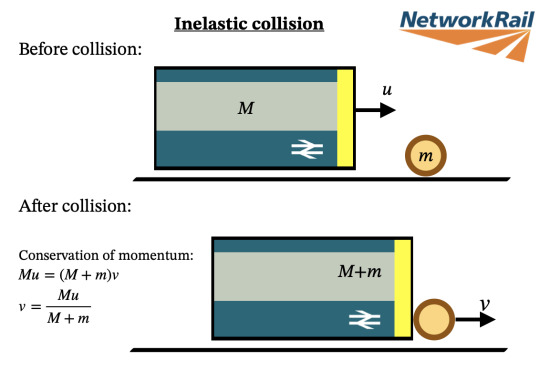
In this case, if we again assume M>>m, we still get v ≈ u.
Since we know from reality that problems will happen if the train collides with the branch, this tells us that we have made an unrealistic assumption somewhere. In this case, it must be the assumption that the train's mass, M, is large enough that the branch's mass m can be ignored. So, without this assumption, we look at how long it takes the train to get back to its initial speed, using the equations for motion under constant power (equations derived from Taylor, 1930 and shown in figure 3):
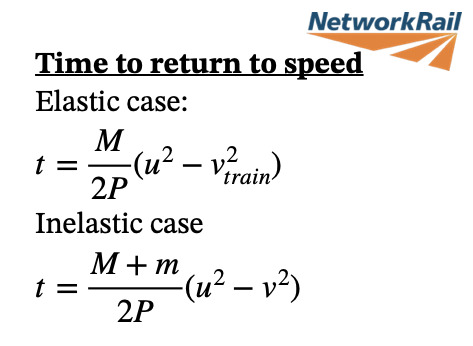
To find how much energy is used in each case, simply multiply the time by the power.
By now, you may be wondering what the point of all this is – after all, I haven't actually shown you if this is meaningful. So let's add some numbers to this and see how reasonable all of our assumptions were!
If we take the train's mass to be M=30 tonnes (30,000kg), its power P=1500kW, and its initial speed u=40 m/s (144 km/hr) respectively; and assume the branch has a mass m=5kg (that seems reasonable, right? Trees are mostly water, which is 1kg per cubic meter, and if it has a radius of 0.5m and a length of 1.435m, it should be about that much), we can calculate all the various things we need:
First, the final velocity of the train and branch in the inelastic case (see figure 2 for the equation):
v≈39.99m/s which is pretty close to the initial velocity.
The time taken to return to speed (fig. 3) for the train/branch system is:
t≈0.0053s
This is quite fast, but hold on: the energy used to do this is about 8000 joules, which is probably quite expensive at current electricity prices, but those are given in kWh and I really don't feel like converting between them. (8000 is a big number, right?)
For the elastic case, things are a little bit more complicated, as we have two different velocities to calculate (figure 4):

If you were just looking at the pictures and are upset that the last two have been equations, don't worry, the next one isn't.
Vbranch ≈ 79.99 m/s
Vtrain ≈ 39.98 m/s
The time taken to return to speed:
t≈0.0094s
This is almost double that of the inelastic case, resulting in the energy used increasing to the enormous –and probably expensive– value of 14 kJ. (I even needed to use an SI prefix this time! And one of the ones that makes things bigger!)
However, both of these cases also reveal some interesting things about the situation: the elastic case has the tree branch launched away from the train at 80m/s, which is about 288 km/hr. Since the train and branch are likely irregularly shaped, the branch probably won't be pushed along the tracks at 290km/hr, and could instead be launched into the air space towards you. Nobody wants to be in the situation where a tree branch is flying towards you at almost 300 km/hr. I could do some math to see how much it would hurt, or if you could reasonably expect to dodge it, but I think we can just assume it will be quite painful.
Historically, trains avoided flinging branches at nearby passengers at almost 500km/hr (that's half the speed of sound) by employing a triangular device on the front of the train to deflect objects such as cows off the tracks. These were particularly common in North America, where lineside fences have yet to be discovered outside of the Northeast Corridor and it is easy for things to wander onto the tracks. However, thanks to innovations by the Budd company and others, more recent american trains are basically indestructible, rendering obstacle deflectors unnecessary. The effects of the obstacle deflector are shown below (figure 5):
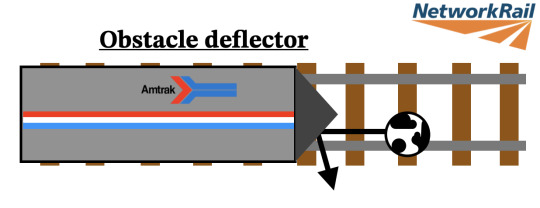
This device is known in America as a burgerizer, since it can provide an easy meal for the train crew –two of the five ingredients for a cheeseburger right on the front of the train, more if you're lucky– although since usually the obstacle is shoved off the track, the British name of "cowcatcher" is misleading, especially if you hit a truck instead. The burgerizer's physics can easily be calculated using conservation of momentum, but this involves vectors, and I don't want to deal with vectors right now is left as an excercise for the reader.
In the inelastic case, we note that the branch sticks to the front of the train. Since the inelastic case is more realistic (I will not justify this statement), this means that other things will also stick to the train. By the time the train reaches the end of the line, the mass of the things stuck to it may end up not being negligible (figure 6):
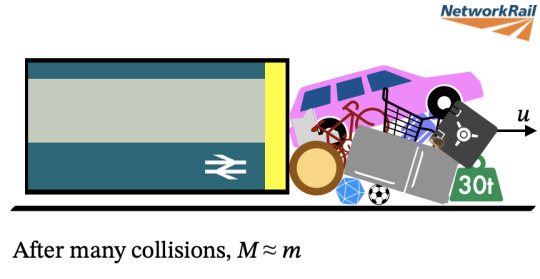
If the train is electric, this will strain the power grid and could lead to power cuts elsewhere as more energy is given to keep the train running at speed. If the train is diesel, it will be unable to provide constant power and could slow down (an electric train has access to every power station in the country if the need arises, a diesel train just has its onboard generator or motor AND a limited amount of fuel).
This mess is also difficult to clean up, and could damage the track as it is pushed along. Also, although we have been ignoring friction (since trains have very little rolling resistance) this pile of stuff will cause friction to be very noticeable, and could even obstruct the driver's visibility – potentially leading to more collisions.
–//–
Now that you have read through all of the calculations (or looked at the pictures and skipped the rest), you should have a thorough understanding of why we have to stop trains to clear things off the line, and can't just plow through them like in the movies. (I assume this happens in movies, I have not checked)
TL;DR: When the train hits a branch, either the branch goes flying towards you really quickly, at basically 1000km/hr, which is approximately the speed of sound; or it sticks to the front of the train and becomes part of a massive pile of things that gets in the way and slows down the train.
Finally:
I put the images together using the shapes in my computer's word processor (except the various rail logos); while the equations of motion under constant power are from this paper by Lloyd W. Taylor (published in 1930, I believe). Also thanks to @cosmos-dot-semicolon for peer reviewing this, any errors are not my fault.
#network rail#physics#trains#network rail essays#I spent way too much time on this you better appreciate it or else#I would not want to get hit by a tree branch moving at roughly mach 2#yes that is a spherical cow in figure 5#please do not leave refrigerators on the railway it is not good for them or the trains#and yes I did get the density of water wrong by a factor of 1000#I want to change it but I think it's funnier if I leave it as it is#a small branch probably is about 5kg though#but if I did use the correct density then the mass of the branch would be 5 tonnes and that very much isn't negligible#in the inelastic case the train's speed is actually reduced to 34m/s and in the elastic case it's reduced to 29m/s which is quite a lot#this also means that the speed of the branch in the elastic case is a thousand times higher at nearly 1.000.000km/hr#which is about 0.09266c so that is quite fast and it's a good thing the collision is inelastic since otherwise it could destroy a city#also I have decided that the train used in these calculations is the BR Class 000
7 notes
·
View notes
Text
Vote in the Audioverse Awards!



Please take a moment to vote for us and our friends in the Audioverse Awards! The more shows you vote for, the more your vote counts.
Buddies featured: @hellofromthehallowoods @amongthestackspodcast @asterpodcastingnetwork @undertheelectricstarspodcast
VOTE HERE
#audioverse awards#indie podcasts#stenchpod#the stench of adventure#among the stacks#hello from the hallowoods#liars and leeches#dreadwood#strong branching out#tales from the radiator#once upon a wasteland#under the electric stars#aster podcasting network
21 notes
·
View notes
Text
Doodling an OC
Hey folks, how's it going? I lowkey forgot my password for a bit, so I haven't been active here.
Anyway, here's a YouTube video of me doodling one of my OCs that's related to some stuff I'm doing on my TikTok channel.
youtube
Here's some links included in the video's description:
#nabali aid network#nabali aid#oob#operation olive branch#all eyes on rafah#krita illustration#digital drawing#youtube#digital art#digital illustration#original character#Youtube
5 notes
·
View notes
Text
Man Trolls 3 really does have a narrative beat of a group of refugees being split while they were escaping being farmed as food, with each side assuming the other dead and on one end giving the likely child-aged daughter of their leader the pressure to lead others for their very survival, and on the other a father so consumed by grief that he doesn't even tell his remaining child she had a sister, and she grows up so similar to said sibling that she might as well be haunting the narrative of the settlement for any survivors who are old enough to remember. And then that just gets put on the sidelines because this is the boy band reunion movie
#with it's own network of unmentioned trauma#trolls band together#trolls 3 spoilers#like branch was old enough to know about the dead poppy sister right you think that would have come up
19 notes
·
View notes
Text
The architectures of these macromolecules can be quite diverse; molecules can be linear or branched or have a comb, ladder or star structure (figure 26.4).

"Chemistry" 2e - Blackman, A., Bottle, S., Schmid, S., Mocerino, M., Wille, U.
#book quotes#chemistry#nonfiction#textbook#architecture#polymers#diversity#linear#branched#comb#ladder#star#cross linked network#dendritic
2 notes
·
View notes
Text
Jubilation's Sweethearts

After a traumatic event left Ashley unable to connect with others, her father takes measures to help her recover. But behind the bright colors and circus animals in the town of Jubilee lurks a darker secret.
(This episode was made in collaboration with @strongbranchpro! Check them out and support their work!)
#aster podcasting network#audio drama#audio fiction#podcasts#podcasting#strong branch productions#spooky summer 2023#Spotify
12 notes
·
View notes
Text
inevitable conclusion to a show with a premise that is so viscerally horrifying. It's the kid's show version of "Not a Deer that gained access to a secure facility with a safety vest and and a clipboard"
Love that while online fandom in general is having a weird meltdown about the morality of enjoying anything darker than sanitized fluff in fiction, the Danny Phantom fandom is still sitting in the corner 16 years after the show ended with a blankie and cocoa and their 10,000th deep-fanon supertorture cannibalism vivisection psychological horror fic
#while fluff does exist in the phandom#the sheer dissonance of “kid's show vibes” vs “visceral horror”#leaves unfilled a huge swath of the phandom ecosystem#law of nature: whatever the source material is lacking in will be energetically supplied by the fandom#the horror is also just so pervasive in the show. so many things are just so chilling#I'd bet good money that DP is like Miraculous Ladybug - the creators pitched an adult show#then Corporate Network Bullshit forces them to repackage it as a kid's show#anyway#the world building is also really interesting and leaves a lot of points to branch off of#phandom#dp#a little bit too old for this but it has the spirit:#streaming wars#fandom culture
19K notes
·
View notes
Text
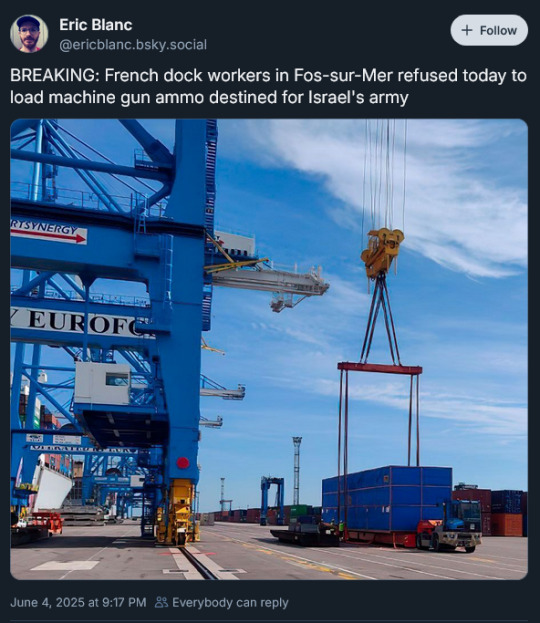
June 4, 2025 - Dockers at a major French port on Wednesday refused to load a container with machine gun spare parts bound for Israel, saying they “will not take part in the ongoing genocide (in Gaza) orchestrated by the Israeli government,” according to broadcaster Franceinfo.
Dockers at the port of Marseille-Fos have set aside a container containing "spare parts for machine guns," and they "will not load it onto the ship bound for Haifa" in Israel, the Gulf of Fos branch of the General Confederation of Labor (CGT) announced in a statement.
The union confirmed that it was alerted by several networks that 19 pallets of Eurolink belts were to be shipped to Israel on Thursday. The Eurolink belts are spare parts for machine guns used by the Israeli army.
"The port of Marseille-Fos must not be used to supply the Israeli army. The dockworkers and port staff of the Gulf of Fos will not take part in the ongoing genocide orchestrated by the Israeli government. We stand for peace among people. We condemn all these armed conflicts that bring death, misery, and the displacement of populations," it added. [link]/[link]
#france#marseille#dockers#dock workers#direct action#industrial action#solidarity#workers#free palestine#palestine#working class#anti-zionism#2025#cgt#unions#israel#idf#fos-sur-mer
15K notes
·
View notes
Text
#The new generation router#based on ARM architecture multi-core processors and non blocking switching architecture#is applied in SD-WAN solution scenarios#integrating routing and switching security to meet the needs of enterprise customers for network equipment routing and switching security.#small and medium-sized enterprise headquarters or branches#and other scenarios.
0 notes
Text
y'all I'm at the point in my career where I seize every reasonable opportunity to schmooze. it would make me sick if I didn't actually deeply care about my work.
#i used to cringe at the very *thought* of networking#now I'm like “hey do you wanna tour of the library?”#“I'm so proud of it please tell me your thoughts”#“You used to manage this branch? tell me everything”#ink rants
0 notes
Text
Cloud WAN: AI-Era Networking For Global Enterprises

Google has been pushing the network for almost 25 years with technologies that connect billions of users to key services like Gmail, YouTube, and Search. Google's massive backbone is the foundation. Google has 202 PoPs, 33 subsea cables, and over 2 million kilometres of fibre, creating a robust global infrastructure. Service level agreements guarantee 99.99% dependability.
Google Cloud and Cross-Cloud Network use the same planet-scale network architecture. Google Cloud's new Cloud WAN solution makes Google's global network available to governments and businesses.
Cloud WAN, a controlled, reliable, and secure corporate backbone, may alter commercial WAN infrastructures. Google's planet-scale network is optimised for application performance. Cloud WAN has 40% cheaper TCO and 40% faster performance than the public internet compared to customer-managed WAN.
Business WAN development
Businesses formerly used pricey multiprotocol label switching (MPLS) networks for safe, reliable site-to-site communication. Rapid use of SaaS and cloud apps necessitated a shift, and SD-WAN with direct internet access (DIA), a cheaper internet-based solution, emerged. To boost application performance, enterprises built colocation-based cloud on-ramps, which increased latency, complexity, and cost. Self-managed equipment and security service edge (SSE) security stacks caused an inconsistent security posture.
Thus, maintaining corporate connections has become more difficult owing to their inherent complexity, which involves many networks with fragmented security and balancing cost, speed, and reliability.
The rapid expansion of AI has taxed business networks. A highly distributed architecture across clouds and on-premises data centres is needed for AI-based applications. It must expand exponentially, provide robust security and privacy, and use resources efficiently and cheaply.
Cloud WAN delivers a single business network solution that ensures optimal performance, cuts costs, and securely connects every company site, application, and user to satisfy these expectations.
Cloud wide area networking (WAN) allows branch and campus links via its Premium Tier network and high-performance connections between geographically isolated data centres.
Use case 1: High-performance cross-regional connection
Large, worldwide clients with extensive data centre networks need reliable data transit. Cloud wide area networking (WAN) connects geographically scattered data centres with a number of connection options, replacing conventional systems with limited capacity, high operating costs, and lower reliability.
These fundamentals enable this use case:
Cloud Interconnect's private and dedicated low-latency connections between Google Cloud regions and on-premise data centres allow you to connect from over 159 locations.
Cross-Cloud Interconnect connects Google Cloud to AWS, Azure, and OCI in 21 regions.
Cross-Site Interconnect provides dedicated point-to-point layer 2 private 10/100G connections optimised to interconnect applications between data centres for corporations, government agencies, and telecom carriers. Google Cloud is the first major cloud provider to offer transparent layer 2 connectivity via Cross-Site Interconnect. Google Cloud is piloting it in a few countries and will expand to additional edge locations next year.
Key benefits of cross-site connection include:
Enterprise-level performance
Google's high-performance global network and Cross-Site Interconnect, a 10/100G data centre interconnect solution, include redundancy and a SLA.
Global reach and capacity
Cross-Site Interconnect operates on Google Cloud's global backbone, which includes over 2 million miles of fibre and trans-Atlantic and trans-Pacific bandwidth.
Risk-and-cost optimised
Cross-Site Interconnect employs redundant fibre infrastructure to dynamically divert network traffic over physical network and optical-fiber problems to maintain service availability.
Google Cloud supports scalable layer 3 routing solutions utilising NCC.
Example 2: Convert campus and branch networks
Google's Premium Tier network securely connects campuses and branch offices to the internet, SaaS apps, and public cloud services. Cloud WAN, a unified, fully managed service that provides on-demand, any-to-any connections with built-in security and a lower TCO, extends Google's trusted network to companies. By providing organisations with the best security and network services, the open yet tightly knit ecosystem encourages flexibility and customised solutions.
Premium networks boost performance by 40%.
Google's unparalleled backbone network gives your apps a secure and lasting foundation for great performance.
The Google Premium Tier network service optimises application performance. It ensures that Cloud WAN internet traffic enters and departs Google's high-performance network at the nearest PoP. Reduced network hops reduce latency and increase user consistency.
With over 5700 direct peering connections and reachability to over 60K autonomous system numbers, Google ranks first among cloud providers and sixth in global peering. This huge peering network ensures efficient traffic exchange with other networks, improving application performance.
Verified Peering Provider lets clients pick ISPs for best availability. The program provides redundant, diversified connections to all ISPs globally.
Dedicated fibre access with Lumen Technologies (available in certain places in 2025) allows customer-operated facilities including data centres, branches, warehouses, and airports to hand off to Cloud WAN.
BT's Global Fabric network-as-a-service (NaaS) may link clients directly to Google Cloud via Cloud WAN.
Cloud wide area networks (WANs) can adapt to modern business connectivity demands. Businesses may link their branches using Cloud VPN or their preferred SD-WAN solution at Network Connectivity Centre, while campuses and data centres can use Cloud Interconnect for 10G, 100G connectivity. Site-to-site data transfer using Network Connectivity Centre is available in 20 countries to expand corporate networks' reach and reliability.
Cloud WAN improves application performance by combining these powerful network technologies, allowing organisations to provide customers what they want.
TCO may be cut by 40% using cloud WAN
Cloud WAN has up to 40% cheaper TCO than customer-managed WAN due to its range of usage-based and fixed-price options. Fixed, upfront costs are also greatly reduced. This quarter, Google Cloud will provide a fixed-price Cloud Interconnect option to organisations that transport high-bandwidth internet traffic. Cloud WANs help enterprises save money by aggregating carrier-neutral facility deployments into fewer cloud regions.
Open, interconnected ecology for freedom and choice
Cloud wide area networking (WAN) helps enterprises build dependable and agile networks with an open, flexible, and linked environment. Many ISV ecosystems offer network and security services that can be linked with cloud WAN:
Large SD-WAN partner community, including Cisco, Fortinet, Juniper Networks, Netskope, Velocloud, and others. Businesses can self-manage or employ managed overlay connections with service partners.
Cloud WAN with NCC Gateway is the first major cloud solution to regulate security service edge (SSE) integration for private and public app users. Palo Alto Networks, Menlo Security, and Broadcom provide SSE.
Flexible security features that incorporate Check Point, Fortinet, and Palo Alto Networks NGFW virtual appliances using Cloud Next Generation Firewall (NGFW) or Network Security Integration.
Partner solutions may enhance Cloud WAN to establish flexible, safe, and automated branch networks and enable the rapid rollout of new branches and services.
Infoblox Universal DDI modernises branch networks with cloud-based, infrastructure-free DNS, DHCP, and IPAM. An optional DNS security feature protects users from malware and phishing when connecting to critical apps.
Juniper Networks Mist delivers AI-driven campus and branch transformation with deep analytics and automation to improve user experiences. This integration includes Wi-Fi, wired access, SD-WAN, NAC, indoor location services, and IoT analytics.
For latency-sensitive applications, connected Google Distributed Cloud (GDC) connectivity brings Google Cloud processing advantages to the edge. GDC supports VMs and containerised apps and is fully managed. It automatically connects to Google Cloud regions via Cloud WAN.
Partner-managed services
Businesses that use managed services providers for corporate backbone can maintain working with them while switching to Cloud WAN. Businesses may also use global system integrators (GSI) for Cloud WAN setup, migration, and operation. Accenture, HCLTech, and Wipro have provided Cloud WAN architecture, design, migration, and continuous management services from inception.
Discover more
Cloud WAN might revolutionise commercial connectivity and worldwide infrastructure security. By offering simplicity, performance, a variety of connectivity and security services, and cost savings, Cloud WAN lets you focus on innovation and development in the cloud and beyond.
Cloud WAN is covered on the Cross-Cloud Network solution page and at Next '25. Check out Google Cloud Next 2025's other great networking breakout sessions.
#technology#technews#govindhtech#news#technologynews#Cloud WAN#business WAN#branch networks#wide area networks#wide area networking#WAN Cloud
1 note
·
View note
Text
कर्नाटक में 13 करोड़ की सोने की लूट का खुलासा: पुलिस ने तमिलनाडु के कुएं से बरामद किया 17.7 किलो सोना, दो बड़े डकैत गिरोह धराए!
Karnataka Bank Robbery: कर्नाटक के दावणगेरे जिले में पिछले साल हुई सनसनीखेज बैंक डकैती का रहस्य आखिरकार सुलझ गया है। पुलिस ने पांच महीने की कड़ी मेहनत के बाद न सिर्फ 17.7 किलोग्राम चोरी का सोना बरामद किया, बल्कि देशभर में फैले दो खूंखार डकैत गिरोहों का भी पर्दाफाश कर दिया। यह सोना भारतीय स्टेट बैंक (SBI) की न्यामती शाखा से 28 अक्टूबर 2024 को चुराया गया था और इसकी कीमत करीब 13 करोड़ रुपये बताई जा…
#17.7 kg gold recovery#bank heist network#Davangere police#Kakarala gang#Karnataka bank robbery#SBI Nyamati branch#six-member gang#Tamil Nadu Madurai#Usalamapatti well#Uttar Pradesh Badayun#Vijaykumar arrest
0 notes
Text
i’ve changed my mind about identity and alienation. i think it’s more that we are always suspended between two or more ideas, no living being has ever been singular in nature. it’s not that we are anything in particular it’s more honest to realize how much we are at once. what i would advance is the impossibility of singularity, there can never be any such thing. the proof is all around us, always and forever. the importance of the monad is not its alienation but rather, the way it highlights that which links on every side in time and space. every singular point conceals an intersection
#monad#singularity#identity#zen#taoism#philosophy#life#growth#alienation#intersection#nexus#hub#branch#branches#trees#tree#data structures#networks#graph#graphs#science#mathematics#geometry
0 notes